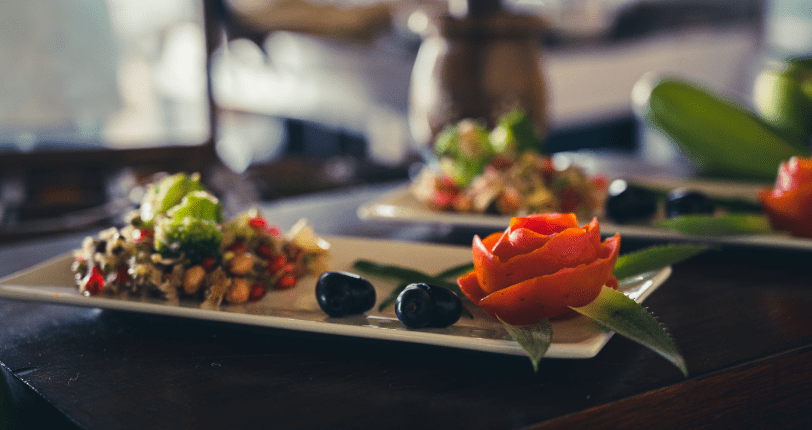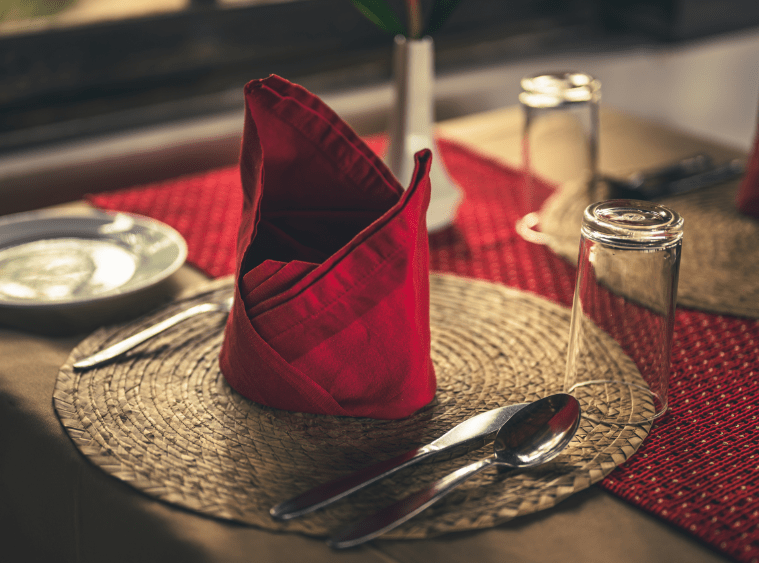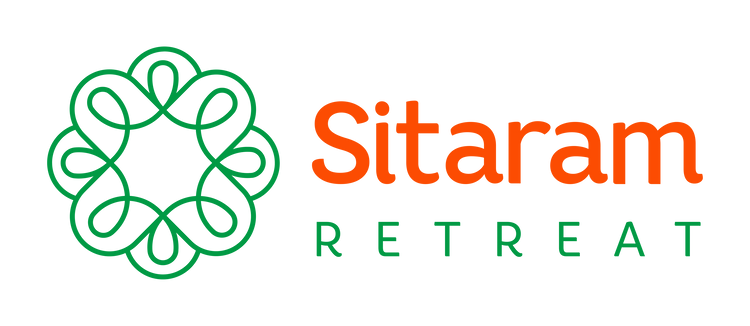Ayurvedic Cuisine
THE POWER OF FOOD
Ayurveda believes that when the food is wrong, no medicines can help. And when the food is right, there will be no need for medicine.
Food is a powerful distraction for humans. It takes the role of a non-prescriptive drug, especially for those suffering from anxiety and depression. When you are stressed out, your instinct is to reach out for fried or sweet foods that give us a false sense of comfort and a mental rush. Just like cigarettes and alcohol, emotional eating is also a strong addictive behaviour.

EVOLUTION AND FOOD CRAVINGS
Our ancestors did not have the same access to sugar and sweet foods that we have. They only had seasonal access to foods only in specific seasons, and this regulated their consumption. Their brains were designed to consume as much sugar, fat and salt as possible whenever it was available.
In the current society, our relationship with food has completely changed as we are not dependent on seasonal availability anymore. All the foods are available at all times. In contrast to the rapid growth in the world, our brains still operate from primitive intelligence where it craves these specific food tastes. When we lack the willpower to regulate our food choices, we end up consuming more sweet, fatty and salty foods than what our bodies can handle.
AYURVEDIC COOKING AT SITARAM
Food is an integral part of treatment in Ayurveda. Food is considered as the prime medicine and eating appropriate food on a daily basis reduces the need for medications.
At Sitaram, in our “slow food vegetarian restaurant”, we serve with love and care – the food best suited for you.
Ingredients for food are sourced from reliable local sources and the use of any artificial ingredients, refined flour, refined sugar and preservatives are strictly avoided. Oil is used very minimally.


Our Food Policy
We believe that food plays an important role in your healing and recovery at Sitaram Beach retreat. We ensure that all our ingredients are fresh, local/organic.
We strictly do not use the following ingredients at Sitaram Beach Retreat
WHY WE DON’T HAVE A BUFFET AT SITARAM RETREATS
Sitaram Retreats are created to provide a space for people, where they can treat their current health issues and relearn the behaviors that cause these issues in the first place. We understand that the environment plays a very important role in changing deeply-conditioned behaviors along with the will power of the person.
Ayurvedic Perspective of Food
The Concept of Six Tastes
These tastes are classified not only by their perception by the tongue but also by their action on the body. The functions of the six tastes are described below.
-
Sweet
- Food substances like ghee, most fruits like bananas, raisins, dates, jackfruit, milk, legumes and grains are considered sweet in taste.
- Sweet reduces Pitta and Vatha.
- It promotes strength, refreshes the senses, promotes hair growth and vital energy. It is very desirable for youth, children, old and fatigued individuals.
- Excessive use of sweet causes imbalance of Kapha And excess fat deposition.
- This results in obesity, poor digestion and diabetes.
-
Sour
- Includes food substances like yoghurt, buttermilk, citrus fruits, unripe mango, pomegranate, tamarind and fermented beverages.
- Sour taste increases Kapha and Pitta.
- It cleans the mouth, increases digestive power, increases taste and loosens the stools. In excess, it causes flabbiness of the body, diminished vision, itching, swelling, skin eruptions, thirst and fever.
-
Salt
- Food substances like natural salts, sea food, fish etc are salty to taste..
- Salt reduces Vatha.
- It destroys stiffness, lubricates tissue, increases digestion, causes perspiration (sweating) and watering of mouth.
- In excess, salt causes inflammatory swellings, baldness, graying of hair, wrinkling, thirst, skin ailments and weakness of the body.
-
Acrid –spicy/ pungent
- Chilly, spices etc are acrid.
- This taste reduces Kapha and increases Pitta and Vata.
- It cures throat ailments, urticaria, skin diseases, indigestion and swelling. It is carminative –improves appetite, increases digestion and metabolism.
- In excess it causes thirst, loss of strength, giddiness, muscle cramps, tremor and aches in hip and back.
-
Bitter
- Bitter taste reduces Pitta and Kapha and increases Vata.
- Most vegetables, especially dark leafy vegetables, herbs, and spices like turmeric are bitter to taste.
- It cures loss of appetite, kills parasites, reduces -thirst, toxicity, skin diseases, giddiness, fever, over secretions of mucous and burning sensation.
-
Astringent
- It is the least common taste among the six tastes. It reduces Pitta and Kapha.
- It is heavy and healthy. It purifies blood, reduces fat deposition and causes dryness.
- In excess it causes abdominal discomfort, abdominal distension, thirst and constipation.
- Vegetables- mostly raw, beans and tea are astringent to taste.
Ayurveda Diet plans followed at Sitaram
Based on the treatment it aids, the food provided is basically divided into different categories:
Ayurvedic Perspective of Food
The Concept of Six Tastes
These tastes are classified not only by their perception by the tongue but also by their action on the body. The functions of the six tastes are described below.
-
AamaPachanaAahara (APA)
AamaPachanaAahara (APA) – is food which helps in improving digestion and reducing inflammation. This is Sitaram’s signature diet which includes fruits, vegetables, rice, side dishes and different pancakes.
-
PoorvaVirechanamAahara (PVirA)
- PoorvaVirechanamAahara (PVirA) – This is a special diet plan served for one or two days just prior to‘VIRECHANAM’, mostly after the ghee therapy.
- The dishes are moderately spicy with added sour taste and fruits like pineapple and citrus are served more.
- The aim is to increase the sections inside the gut which will enable better removal of toxins through purgation.
-
PoorvaVamanamAahara (PVA)
- This diet plan is followed only for one day prior to vomiting therapy.
- Food served will be heavy and contains sweet and carbohydrate-rich dishes. Sesame, yoghurt, black gram and jaggery are included.
- This food will increase the slime / phlegm in the gut which sticks to the ghee and toxins inside. This ensures better removal of slime when vomiting is performed.
-
PeyadiAahara (PA)-Peya
- PeyadiAahara (PA)-Peya means ‘kanji’or rice gruel. The food consists of only rice gruel and a small amount of a side dish.
- Peyadiaahara is given at times when digestion is low.
- This diet plan is usually advised when you are in the ghee therapy and on the days of cleansing like VAMANAM or VIRECHANA.
- Kanji will also be advised when your doctor feels that your digestive fire is too low and needs improvement for the better efficacy of medicines and treatment.
-
Five meal Plan (FMP)
- Five meal Plan (FMP) – In this diet plan, we serve normal food, but in lesser quantities. In between the regular meal timings, fruits or boiled vegetables are served.
- The idea is to serve you less quantity of food than usually given in the regular three meal plan.
- This diet plan along with the treatment helps in reducing unwanted body weight.
-
Gluten Free Diet (GFD)
- Gluten containing grains like wheat and oats are avoided for guests who are gluten intolerant.
- This diet plan is also advised for guests who are having certain health conditions like autoimmune diseases, impaired digestion, and inflammation in the body.
-
Lactose Free Diet (LFD)
All lactose containing items are avoided from your food if you have been advised a lactose free diet plan.
-
Diabetic Diet (DD)
For guests with high levels of glucose in their blood, diabetic diet is advised which aims at reducing carbohydrate and sugar intake.
As our diet is tailor made according to your requirements and clinical condition, we take care to avoid any food items which you are specifically allergic to.
SPECIFIC DIETS AT SITARAM RETREATS
Panchakarma treatment has three phases:
Ayurvedic Perspective of Food
The Concept of Six Tastes
These tastes are classified not only by their perception by the tongue but also by their action on the body. The functions of the six tastes are described below.
-
Preparatory Therapy
We serve light foods during the preparatory phase that does not cause bloating and are easy to digest. This is done to aid and prepare your body for the purificatory therapies.
For people with low appetite and irregular bowel movements, the cause could be high mucus in the gut. In such cases, we add specific herbs that increase Agni and strengthen the metabolism. This is called Ama Pachana Aharam.
For people with high food cravings, we aim to retrain your mind and body to extract maximum energy from standard portion size and avoid the habit of binge-eating. In Ayurveda, Vipaka – after taste of the food is an important factor. You Should feel light and energetic after eating. In such cases, we serve a five time meal plan. The idea is to not starve and lose your high cravings gradually.
-
Purificatory Phase
The treatments done during this phase have food guidelines that need to be followed along with the treatment. Panchakarma is a detoxifying therapy. Once a toxin is identified, we give food that activates the particular dosha in the body before eliminating it.
For example, before Virechana – induced purgation, we serve foods that are sour in nature like veg biryani, tamarind and pineapple. This activates the Pitta, and during Virechana, it is easier to flush it out from the body. The purpose of Virechana is to balance Pitta, and by giving these foods, we artificially create a slight increase in Pitta and during the treatment, the body flushes out all the excess Pitta from the body.
Likewise, for balancing Kapha, we do Vamana. The diet is followed before the therapy increases Kapha and makes the flushing process easier.
This phase follows a therapy oriented diet that aids the treatment process.
-
Post-purification Recovery Phase
After the purification phase, your gut would be very sensitive and the diet should be extremely light in nature. We serve a lot of soups – especially Kanji – rice soup that is easy to digest.
Once your metabolism is back to normal, we gradually introduce normal and nourishing foods.
For diabetic people, we serve a conscious diet that monitors the glycemic index. Likewise, for people with joint issues, or arthritis, we have a different diet that has high additions of anti-inflammatory foods.


 retreat@sitaramayurveda.com
retreat@sitaramayurveda.com +91 813 8888 912
+91 813 8888 912






